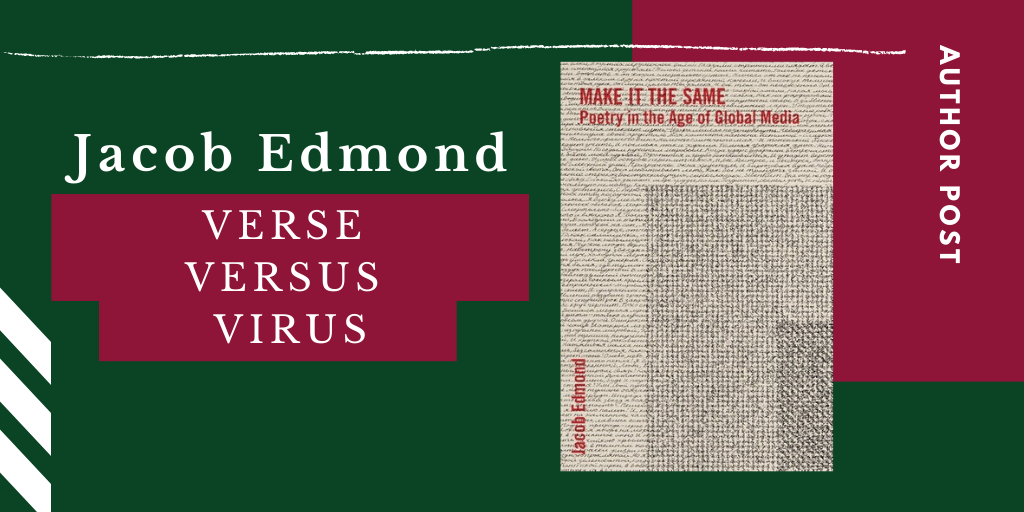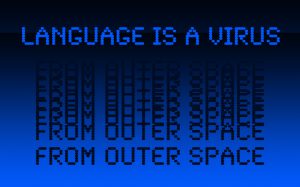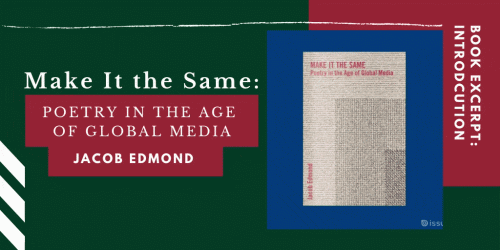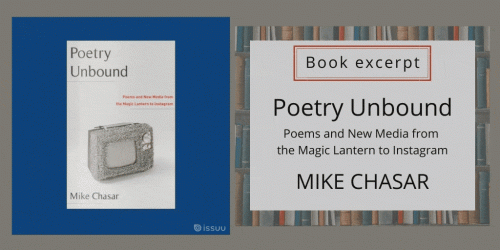Verse Versus Virus
By Jacob Edmond

“Make It the Same rebuts the notion that formal word-games are a decadent first-world hobby. It is an empirically broad, thoughtfully constructed, well-written, timely book about an important subject: a technical ‘mode of production’ prominent in contemporary poetry, with its effects on content and reception.”
~Haun Saussy, author of The Ethnography of Rhythm: Orality and Its Technologies
We are starting off our celebration of National Poetry Month with by Jacob Edmond, author of Make It the Same: Poetry in the Age of Global Media. In this guest blog post, Edmond considers how language spreads like a virus and why we live in a world of copies.
Originally published in Newsroom. Enter this week’s drawing for a chance to win a copy of the book.
• • • • • •
“Language is a virus from outer space,” wrote William Burroughs. It might seem wildly inappropriate to invoke this bizarre statement at a time when a real virus is infecting and killing thousands worldwide, upending the everyday lives of millions, and unsettling the global economy. And yet Burroughs gets at something important: certain ways of using language are infectious and can affect our reality, including the current global pandemic. Real viruses spread—or don’t spread—because of political and social decisions that are shaped by language; and their impact comes not just from their spread but from the infinitely faster way news and fear of their spread moves around the globe.
For the past ten years I’ve been writing about a form of literature for which Burroughs is especially known: texts made from other texts, or what I call “copy literature.” “Copy literature” come in all shapes and sizes. It might be made of lines from pop songs, phrases from online restaurant reviews, or snippets from news articles. It includes, for example, Bill Manhire’s found poem “written out of comments in the Visitors’ Book in Shackleton’s hut at Cape Royd”; the late great Barbadian poet Kamau Brathwaite’s moving adaptation of a West African drum ritual; Tobagonian Canadian poet NourbeSe Philip’s poem about the mass slaughter of Africans on board the slave ship Zong made entirely from an eighteenth-century text documenting the atrocity; and Brion Gysin and Burroughs’s works made from cut-up newspapers.
“Copy literature highlights and responds to an important fact: we live in a world of copies. Just as the novel coronavirus spreads by reproducing itself, so ideas, news items, cute cat videos, and the like circulate online because they are copied and so repeated.”
Though it may seem farfetched, these seemingly obscure works of copy literature actually have something significant to teach us about contemporary culture and about the situation the world finds itself in today as it faces a new global pandemic.
Copy literature highlights and responds to an important fact: we live in a world of copies. Just as the novel coronavirus spreads by reproducing itself, so ideas, news items, cute cat videos, and the like circulate online because they are copied and so repeated. Every time, you like or share something on social media, or even stop scrolling to glance at a story in your news feed, you increase the number of copies of that snippet of information in the world. Added together, all these acts of copying affect what is shared online, what we read and view, and so profoundly shape our understanding of the world.
In times of crisis, the effects of copying and repetition are magnified for good and ill. Rapid and widespread copying, for instance, drives panic selling on world stock markets and helps spread racist rumours and scare mongering about Covid-19. But equally, the sharing of information among health experts and governments is key to our chances of overcoming the current global epidemic with the lowest possible loss of life.

Like everyone else, writers are interested in what gets repeated and why, and like many of us, they often worry about the accuracy of the news stories that circulate. That worry is as old as the news itself. Many eighteenth-century commentators lamented the inaccuracies and political biases of their news media. Caleb Whitefoord, for instance, wrote in 1799: “It is generally believed, that we Editors . . . are enabled to inform the public . . . of everything that is acting in the great theatre of the world. . . . It is unnecessary to tell you that this is a mistaken notion.” Whitefoord went on to advise editors of a simple solution to the lack of accurate information: make it up! “If once in a hundred times you have been right in your conjecture, you have matter of triumph for months.” So long as you are correct once in a while, Whitefoord observed, no one will care that the rest of the time you are trading in fake news.
Fake news is nothing new and neither is literature made by copying the news. Whitefoord and other late eighteenth-century wits mocked the confused information provided by the newspaper with their own form of copy poetry. By reading across the columns of different articles, they produced poems that satirized the absurd jumble of more or less unreliable information that was the late eighteenth-century newspaper. For example, one such copy poem begins: “In the House of Commons, yesterday, Lord N— / Received 500 lashes, pursuant to his sentence.” They called this new satirical form of poetry “cross-reading.”
“Cross-reading” poems are the predecessors of more recent forms of copy poetry, as well as of the humorous juxtapositions found in many of today’s memes. In the early 1970s, Gil Scott Heron, for example, did something similar to those eighteenth-century cross-reading poems in producing what became his greatest hit. “The Revolution Will Not Be Televised” is made largely from quotations or quasi-quotations from news media and advertising. Heron’s spoken-word song or poem and particularly its title and refrain quickly went viral. Today a search for versions of the phrase “the revolution will not be” yields over half a million results.
“Fake news is nothing new and neither is literature made by copying the news.”
Like news stories and Heron’s title, viruses circulate because they replicate themselves as they move from host to host. Yet to talk about pop songs, funny memes, or videos as “going viral” is to use a metaphor. As we are only too well aware in the midst of the Covid-19 pandemic, there is a big difference between an actual virus that infects our bodies and threatens our lives and the number of shares a YouTube video accumulates. A virus is mindless and is spread, for the most part, involuntarily by its human or animal hosts. Words, ideas, videos, and images, on the other hand, are spread online and watched for the most part voluntarily by people looking to keep up with the latest thing.
It is important to recognize the viral metaphor as a metaphor, but it is equally important to recognize the relationship between the spread of real viruses and the repetition of texts and ideas. When it comes to real viruses, human decisions and ideas too can be deadly. Samoan-Palagi poet Serie (Cherie) Barford, for instance, reminds us of the atrocious decision of a New Zealand medical officer to allow passengers carrying the 1918 flu pandemic to disembark in Apia:
Aboard Talune the Doctor examines
bodies propped by mail bags
Colonel Logan agrees
“yes,
a sea-sick lot this one.”
The ocean is calm.
Today the Samoan Times is all news:
death notices and a front page
Today the editor died
Today Teuuila’s screams awoke me
as she lay between her parents
dipping fingers in their sweat
. . .
At Papauta Girls’ School desks are empty
Colonel Logan shouts “I do not care if they
are going to die. Let them die and go to Hell.”
Barford here quotes the shocking words of the New Zealand military administrator of Samoa at the time. Colonel Robert Logan not only refused to help this school hit badly by the virus but, even more shockingly, refused an offer of medical help from American Samoa, so contributing significantly to the devastating effect of the epidemic, which took the lives of around twenty percent of the Samoan population.
It seems likely that Logan’s callous disregard for Samoan lives was the result, at least in part, of the dangerous, pernicious, and widespread notion of British and European superiority. Such notions of white supremacy are another example of contagious and dangerous ideas. Virally spread around the world by European empires, these notions, as we know only too well a year after the massacre in Christchurch, continue to circulate today.
Texts and ideas are, like viruses, contagious and they spread through repetition. But unlike viruses, we have greater choice about what gets repeated and how. Poems and other works of literature can cause us to reflect on the circulation of news and information, on its uses and misuses. They can prompt us to pause and question the human decisions that allow some ideas to go (metaphorically) viral and that stop others in their tracks. In the face of a real viral pandemic, we need now more than ever to confront this power of repetition.






